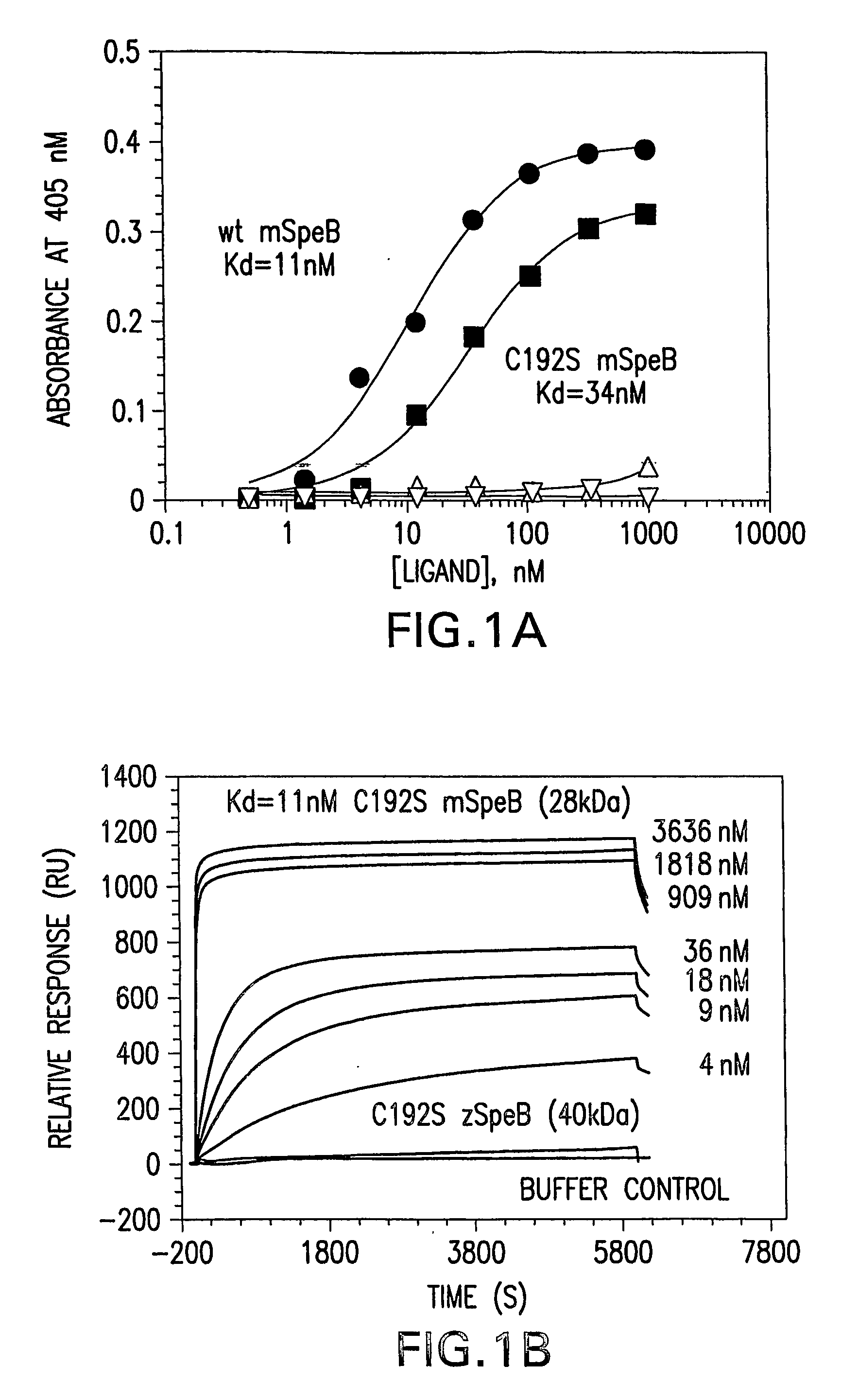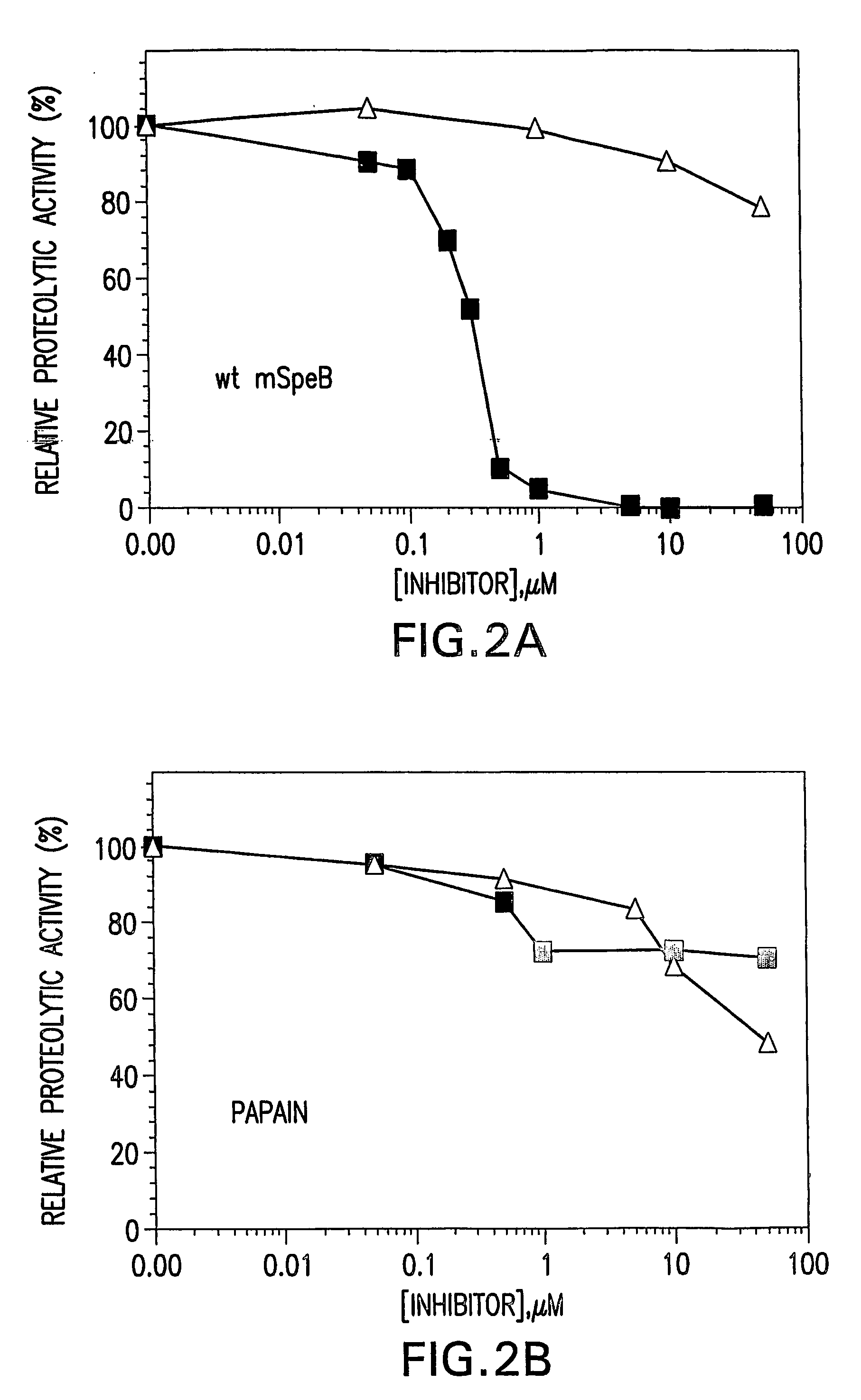Recombinant expression of streptococcus pyogenes cysteine protease and immunogenic compositions thereof
a technology of pyogenes cysteine protease and recombinant expression, which is applied in the field of molecular biology, clinical bacteriology and protein folding, can solve the problems of ineffective antibiotic treatment of toxic shock and severe invasive disease, failure of penicillin to treat severe invasive streptococcal infections, and high mortality
- Summary
- Abstract
- Description
- Claims
- Application Information
AI Technical Summary
Benefits of technology
Problems solved by technology
Method used
Image
Examples
example 1
Materials and Methods
[0121] Media and reagents. E. coli BLR(DE3) (Novagen, Calif.) was used for all expression studies. Bacteria were grown in Luria broth (LB) under appropriate antibiotic selection conditions. Ampicillin was used at a concentration of 100 μg / mL and kanamycin at 50 μg / mL. ZeroBluntTOPO cloning vector pCR-Blunt (InVitrogen, Carlsbad, Calif.) was used for cloning of PCR generated fragments. Century-Plus RNA Markers™, Millennium RNA Markers™, RNAlater™, RNAqueous-Midi™, DNA-free™, ULTRAhyb™, NorthernMax™ and RETROscript™ were obtained from Ambion (Austin, Tex.). GeneScreen™ hybridization membrane, Flurorescein-N6-dATP, Renaissance® Antifluorescein-AP conjugated polyclonal antibody, and CDP-Star® were acquired from PerkinElmer Life Sciences, Boston, Mass. All restriction enzymes were procured from New England Biolabs (Beverly, Mass.).
[0122] Polymerase Chain Reaction. Unless noted otherwise, PCR amplifications were performed in a 50 μL final volume utilizing the follow...
example 2
Inhibitory and Chaperone Activities of the SpeB Pro-Sequence Domain
[0145] Recombinant expression of mature SpeB, lacking its NH2-terminal pro-sequence domain, results exclusively in the production of insoluble protein in E. coli (Matsuka et al., 1999). The requirement of the pro-sequence domain to govern production of soluble mature SpeB suggests that the domain might function as an intramolecular chaperone to direct proper folding of the protein. To examine such activity, the SpeB pro-sequence domain, the 40 kDa SpeB zymogen, as well as mature wild-type SpeB and mature C192S SpeB, were expressed and purified from E. coli for characterization (data not shown). Association of the pro-sequence domain and mature SpeB proteins was investigated through the use of ELISA (FIG. 1A) and surface plasmon resonance (SPR) using a Biocore 3000 (FIG. 1B). Using the calculation parameters specified in Example 1, the interaction of the pro-sequence domain with the wild-type and C192S mature SpeB wa...
example 3
Two-Plasmid Based Co-Expression of the SpeB Pro-Sequence Domain and Mature SpeB
[0148] The ability of the pro-sequence domain to direct correct refolding of the mature SpeB polypeptide in vitro, suggests that independent co-expression of the two proteins in vivo would potentially result in the production of correctly folded mature SpeB. Thus, in this example, a two-plasmid co-expression system was developed where one plasmid encoded the pro-sequence domain (pLP682), and the other the mature SpeB polypeptide (pLP680 or pLP681) (FIG. 4). E. coli transformed with either pLP680 or pLP681 alone, or co-transformed with pLP682, were used to investigate protein expression using SDS-PAGE and Western blot. Sole expression of either the mature wild-type or mature C192S SpeB construct (data not shown) resulted in the production of predominantly insoluble 28 kDa mature SpeB. This suggests that expression of mature SpeB in the absence of the pro-sequence domain results in the production of incorr...
PUM
| Property | Measurement | Unit |
|---|---|---|
| incubation time | aaaaa | aaaaa |
| incubation time | aaaaa | aaaaa |
| dissociation constant | aaaaa | aaaaa |
Abstract
Description
Claims
Application Information
 Login to View More
Login to View More - R&D
- Intellectual Property
- Life Sciences
- Materials
- Tech Scout
- Unparalleled Data Quality
- Higher Quality Content
- 60% Fewer Hallucinations
Browse by: Latest US Patents, China's latest patents, Technical Efficacy Thesaurus, Application Domain, Technology Topic, Popular Technical Reports.
© 2025 PatSnap. All rights reserved.Legal|Privacy policy|Modern Slavery Act Transparency Statement|Sitemap|About US| Contact US: help@patsnap.com



